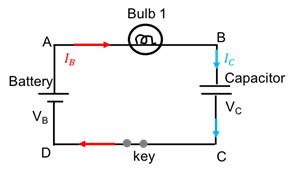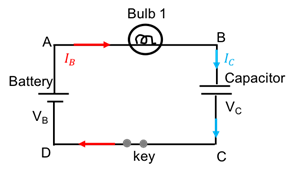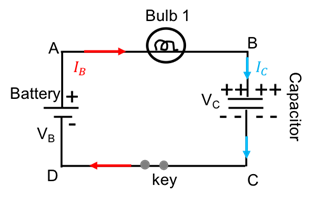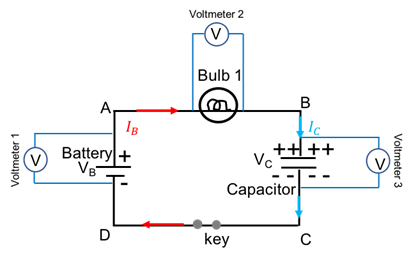
A capacitor is connected to a battery, bulb, and switch as shown. Assume that the switch has been closed for an extended period of time.

1. Predict whether the brightness of the bulb is the same as, greater than, or less than the brightness of a single bulb connected to a battery. Explain.
2. Predict how the potential difference across the battery to the potential differences across the capacitor plates and to the potential difference across the bulb. Explain.
3. Briefly describe the distribution of charge, if any, on the capacitor plates.
Recall the relationship between the charge on a capacitor and the potential difference across the capacitor. Use this relationship to describe how you could use a voltmeter to determine the charge on a capacitor.
4. Obtain the circuit and a voltmeter. Check your predictions for parts 1 and 2.
(1)
To Explain:Whether the brightness of the bulb is the same as, greater than or less than the brightness of a single bulb connected to a battery.
Answer to Problem 1aT
Brightness of the bulb changes with the time in RC circuit but it is constant in case of battery only.
Explanation of Solution
Introduction:
Ohm’s Law: The current in the circuit is directly proportional to the potential difference and the constant of proportionality is known as resistance R.
The potential difference across the capacitor is given as:
Where,
A RC circuit with a battery connected to the capacitor through a Bulb with a resistance of

Figure 1: A RC circuit with a battery, bulb and a capacitor
After a long time, the circuit will behave as an open circuit and Therefore, current in the circuit drops to zero with the time till the capacitor voltage equals to the battery voltage.During initial moment, the brightness of the bulb in this RC is equivalent to the single bulb with the battery.But as the time passes, current starts dropping, hence, brightness decreases till the circuit becomes open due to the charging of the capacitor.
Conclusion:
Brightness of the bulb changes with the time in RC circuit but it is constant in case of battery only.
(2)
To Compare: The potential difference across capacitor, bulb and battery.
Answer to Problem 1aT
The voltage difference between the terminals of the battery is
Explanation of Solution
Introduction:
Ohm’s Law: The current in the circuit is directly proportional to the potential difference and the constant of proportionality is known as resistance R.
The potential difference across the capacitor is given as:
Where
A RC circuit with a battery connected to the capacitor through a Bulb with a resistance of

Figure 2: A RC circuit with a battery, bulb and a capacitor
The voltage difference between the terminals of the battery is
Hence, the voltage through the loop can be written as:
Conclusion:
The voltage difference between the terminals of the battery is
(3)
Charge distribution on the plates of the capacitor.
Answer to Problem 1aT
One of the plates accumulates positive and other negative charge in equal magnitude.
Explanation of Solution
Introduction:
The charge on the capacitor is directly proportional to the potential difference across the capacitor plates,
Where ‘C’ is the constant known as the capacitance which depends on the material and design property of the capacitor.
In given circuit, shown in Figure 3, the positive terminal of the battery is connected with the upper plate of the capacitor and the lower one with negative terminal of the battery.

Figure 3: Charge distribution on the capacitor
Current flows from positive terminal of the battery to towards the bulb. Basically, current is in the opposite direction of the flow of the electrons. Electrons from the upper plate of the capacitor starts moving towards positive terminal of the battery and leaves the upper plate positive and electrons in the lower plate are repelled from the negative terminal of the battery. This accumulation of the charge happens till the potential difference across the plate is equal to the battery voltage. Also, the charge on the plates is equal in magnitude and opposite in charge.
Conclusion:
Hence, one of the plates of the capacitor accumulates positive and other negative charge in equal magnitude.
(4)
To Check: The predictions using voltmeter in the circuit.
Explanation of Solution
Introduction:
Ohm’s Law: The current in the circuit is directly proportional to the potential difference and the constant of proportionality is known as resistance R.
The charge on the capacitor is directly proportional to the potential difference across the capacitor plates,
Where ‘C’ is the constant known as the capacitance which depends on the material and design property of the capacitor.
In given circuit, shown in Figure 4, voltmeters are connected parallel to the battery, bulb and the capacitor in order to observe the potential for each circuit element after capacitor is fully charged. Once the capacitor is fully charged, circuit becomes open circuit and hence, no current flows through the circuit.

Figure 3: Circuit to calculate Vpotential across battery, bulb and the capacitor
Let say the battery has a
After a long time,the battery voltage is dropped cross the capacitor andpotential across the capacitor is calculated as 5 V and the voltmeter 3 reads 5 V.
Potential across the bulb, and the voltmeter 2 reads 0 V.
Voltmeter 1 reads 5 V.
Charge on the capacitor will be:
Conclusion:
Hence, potential across the battery and the capacitor is 5 V and the bulb is 0 V. Charge on the capacitor is
Want to see more full solutions like this?
Chapter 6 Solutions
Tutorials in Introductory Physics
Additional Science Textbook Solutions
Chemistry: Structure and Properties (2nd Edition)
College Physics: A Strategic Approach (3rd Edition)
Genetic Analysis: An Integrated Approach (3rd Edition)
Applications and Investigations in Earth Science (9th Edition)
Biology: Life on Earth (11th Edition)
Chemistry: An Introduction to General, Organic, and Biological Chemistry (13th Edition)
- No chatgpt plsarrow_forwardA car in a roller coaster moves along a track that consists of a sequence of ups and downs. Let the x axis be parallel to the ground and the positive y axis point upward. In the time interval from t 0 tot = = 4s, the trajectory of the car along a certain section of the track is given by 7 = A(1 m/s)ti + A [(1 m/s³) t³ - 6(1 m/s²)t²]ĵ where A is a positive dimensionless constant. At t car ascending or descending? = 2.0 S is the roller coaster Ascending. Descending.arrow_forwardneed help on first part its not 220arrow_forward
- No chatgpt pls will upvotearrow_forwardNo chatgpt plsarrow_forwardChildren playing in a playground on the flat roof of a city school lose their ball to the parking lot below. One of the teachers kicks the ball back up to the children as shown in the figure below. The playground is 6.10 m above the parking lot, and the school building's vertical wall is h = 7.40 m high, forming a 1.30 m high railing around the playground. The ball is launched at an angle of 8 = 53.0° above the horizontal at a point d = 24.0 m from the base of the building wall. The ball takes 2.20 s to reach a point vertically above the wall. (Due to the nature of this problem, do not use rounded intermediate values-including answers submitted in WebAssign-in your calculations.) (a) Find the speed (in m/s) at which the ball was launched. 18.1 m/s (b) Find the vertical distance (in m) by which the ball clears the wall. 0.73 ✓ m (c) Find the horizontal distance (in m) from the wall to the point on the roof where the ball lands. 2.68 m (d) What If? If the teacher always launches the ball…arrow_forward
- It is not possible to see very small objects, such as viruses, using an ordinary light microscope. An electron microscope can view such objects using an electron beam instead of a light beam. Electron microscopy has proved invaluable for investigations of viruses, cell membranes and subcellular structures, bacterial surfaces, visual receptors, chloroplasts, and the contractile properties of muscles. The "lenses" of an electron microscope consist of electric and magnetic fields that control the electron beam. As an example of the manipulation of an electron beam, consider an electron traveling away from the origin along the x axis in the xy plane with initial velocity ₁ = vi. As it passes through the region x = 0 to x=d, the electron experiences acceleration a = ai +a, where a and a, are constants. For the case v, = 1.67 x 107 m/s, ax = 8.51 x 1014 m/s², and a = 1.50 x 10¹5 m/s², determine the following at x = d = 0.0100 m. (a) the position of the electron y, = 2.60e1014 m (b) the…arrow_forwardNo chatgpt plsarrow_forwardneed help with the first partarrow_forward
- A ball is thrown with an initial speed v, at an angle 6, with the horizontal. The horizontal range of the ball is R, and the ball reaches a maximum height R/4. In terms of R and g, find the following. (a) the time interval during which the ball is in motion 2R (b) the ball's speed at the peak of its path v= Rg 2 √ sin 26, V 3 (c) the initial vertical component of its velocity Rg sin ei sin 20 (d) its initial speed Rg √ sin 20 × (e) the angle 6, expressed in terms of arctan of a fraction. 1 (f) Suppose the ball is thrown at the same initial speed found in (d) but at the angle appropriate for reaching the greatest height that it can. Find this height. hmax R2 (g) Suppose the ball is thrown at the same initial speed but at the angle for greatest possible range. Find this maximum horizontal range. Xmax R√3 2arrow_forwardAn outfielder throws a baseball to his catcher in an attempt to throw out a runner at home plate. The ball bounces once before reaching the catcher. Assume the angle at which the bounced ball leaves the ground is the same as the angle at which the outfielder threw it as shown in the figure, but that the ball's speed after the bounce is one-half of what it was before the bounce. 8 (a) Assuming the ball is always thrown with the same initial speed, at what angle & should the fielder throw the ball to make it go the same distance D with one bounce (blue path) as a ball thrown upward at 35.0° with no bounce (green path)? 24 (b) Determine the ratio of the time interval for the one-bounce throw to the flight time for the no-bounce throw. Cone-bounce no-bounce 0.940arrow_forwardA rocket is launched at an angle of 60.0° above the horizontal with an initial speed of 97 m/s. The rocket moves for 3.00 s along its initial line of motion with an acceleration of 28.0 m/s². At this time, its engines fail and the rocket proceeds to move as a projectile. (a) Find the maximum altitude reached by the rocket. 1445.46 Your response differs from the correct answer by more than 10%. Double check your calculations. m (b) Find its total time of flight. 36.16 x Your response is within 10% of the correct value. This may be due to roundoff error, or you could have a mistake in your calculation. Carry out all intermediate results to at least four-digit accuracy to minimize roundoff error. s (c) Find its horizontal range. 1753.12 × Your response differs from the correct answer by more than 10%. Double check your calculations. marrow_forward

 Physics for Scientists and Engineers, Technology ...PhysicsISBN:9781305116399Author:Raymond A. Serway, John W. JewettPublisher:Cengage Learning
Physics for Scientists and Engineers, Technology ...PhysicsISBN:9781305116399Author:Raymond A. Serway, John W. JewettPublisher:Cengage Learning Glencoe Physics: Principles and Problems, Student...PhysicsISBN:9780078807213Author:Paul W. ZitzewitzPublisher:Glencoe/McGraw-Hill
Glencoe Physics: Principles and Problems, Student...PhysicsISBN:9780078807213Author:Paul W. ZitzewitzPublisher:Glencoe/McGraw-Hill
 College PhysicsPhysicsISBN:9781938168000Author:Paul Peter Urone, Roger HinrichsPublisher:OpenStax College
College PhysicsPhysicsISBN:9781938168000Author:Paul Peter Urone, Roger HinrichsPublisher:OpenStax College Physics for Scientists and EngineersPhysicsISBN:9781337553278Author:Raymond A. Serway, John W. JewettPublisher:Cengage Learning
Physics for Scientists and EngineersPhysicsISBN:9781337553278Author:Raymond A. Serway, John W. JewettPublisher:Cengage Learning





